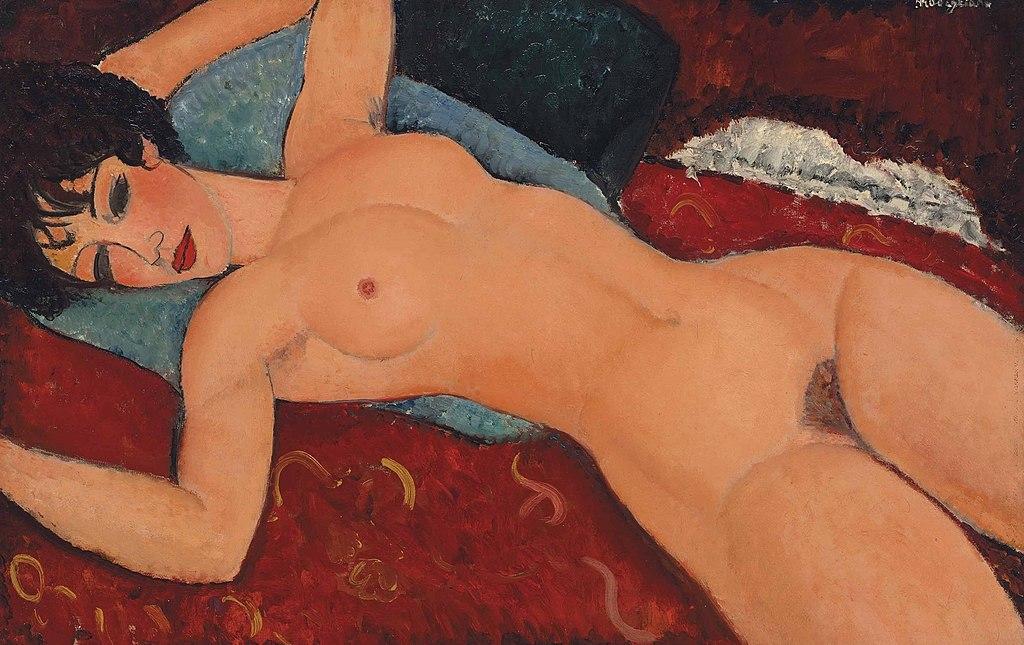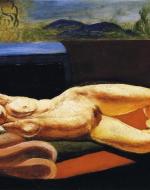Created by Emera Gregor on Sun, 02/25/2024 - 19:06
Description:
Display Explanation:
Welcome to Modigliani’s studio!
This art installation titled Desire in Studio will allow you to look into a replication of Amedeo Modigliani’s studio. Deriving from the Latin studium meaning to study, we imagine what Modigliani’s studio may have looked like while he painted the Red Nude, surrounding himself with some related artworks by the very artists that he studied and was inspired by.
Upon entering the museum, you will eventually find yourself in the basement or basement-like area. The pathway to the exhibit will remind you of an old building and it will be dimmer than on other floors to be slightly reminiscent of the Bateau-Lavoir that Modigliani had squatted in. You will then come upon the exhibit: a room within a room. Viewers of the exhibit peer inward through this see-through room that showcases Modigliani’s studio.
In the section where the viewers stand, the walls are a dark stormy blue with plank-like flooring. The arrangement of the room they look into is meant to mimic a popular photograph of Modigliani at his studio in 1915. Within the studio, the plank-like floor continues but the walls are a slate gray, almost looking unfinished. On the left-hand side of the exhibit, there is a brown, wooden door. A few feet in front of the door is a wooden desk with a wooden chair pulled out and cocked to the side, like Modigliani had just gotten up from it. Next to the desk on the wall are the three paintings, each at different heights and sizes.
The biggest and closest (30x36) to where the viewers stand is Modigliani’s Red Nude. As this is the only work that is actually Modigliani’s, it needs to be the most prominent. This painting would be about 2.5 feet from the ground. Next to the Red Nude would be Henry Matisse’s Blue Nude. Matisse was, aside from Pablo Picasso, perhaps Modigliani’s most prominent influencer. This image would be up a bit higher than the Red Nude (about 3.5 feet), but smaller (16x24). Next to the Blue Nude would be Moise Kisling’s Reclining Nude, a painter that was known to work closely with Modigliani. This would be placed about 2 inches lower than the Blue Nude and would also be 16x24. Leaning against the desk leg closest to the viewers would be Henri de Toulouse-Lautrec’s Reclining Nude, another artist that influenced Modigliani.
The rest of the room would be in disarray, meant to feel lived in and occupied. The desk would be messy as if he had just been painting with an old-fashioned cigarette able to be seen. The floor would have miscellaneous papers, supplies, and paint stains around. Some of the papers would be face up, showing sketches of other Modigliani works. Some would be blank. Next to the door, you could see a storage shelf full of an artist’s supplies. Interestingly, he would also have some candles in the room and well as big, fancy curtains on the window. While Modigliani was a struggling artist, he tried to keep up appearances through his decorations.
Installation Note:
Each of the images, Red Nude, Blue Nude, and Reclining Nude, portray women as sexual beings through a suggestion of invitation rather than active seduction. Each of these artists paint their subject in a way that is pleasing to a male audience: nude, curvy, and open-positioned. Modigliani’s Red Nude, Matisse’s Blue Nude, and Kisling’s Reclining Nude all place the viewer in an above position gazing downward at a woman’s body. Furthermore, she appears to be comfortable to be looked at as her body opened up, arms outstretched rather than hiding something. None of the women being depicted are looking directly at the viewer—she is not seducing them—but she is open to romance.
Each of the images differ slightly in their approach. Matisse, Modigliani’s main influencer of the chose works, takes an aggressive approach (at least, to those in his time) with this painting. He uses red and blue to highlight erogenous zones and the areas around them, ensuring that the viewer’s attention is drawn there. The main sources of color exist only in the background, depicting green foliage, and in her makeup, depicting beauty and sexuality. She is in a natural setting as she opens up her body to view and is drawn with very angular lines, something that earned this painting to be known as primitive. The woman is able to be comfortably sensual and naturally inviting.
Kisling, who worked closely with Modigliani, places his subject in a more refined light. She is relaxed and looking off to the side, possibly at someone. Unlike Red Nude, she takes up less space on the canvas but is still the main focus of the image. Behind her is an image of the outdoors, which, just like Matisse, indicates that the subject is natural in what she is doing. Her body is pretty much one color, except for her bold makeup, accentuating her beauty and sexuality. Additionally, her legs are partially open, adding to the idea of invitation to whomever she may be looking at.
Modigliani’s painting itself is the most sexual of the installation. His subject is very much idealized with an hourglass body, long neck, slender eyebrows, and dark makeup. The choice of red is very much intentional, giving a clear tone of desire. Yet, the woman is not looking at the viewer. She is confident and not afraid to be seen in a way that is encouraging to the viewer to think of her in a sexual light. It is Modigliani using the male gaze that portrays women as sexual beings yet promotes masculinity as the chaser. While the image is primarily centered on her torso, the viewer can also see an opening between her legs, adding to the idea of invitation the same way as Kisling. Unlike the other artists in the installation, Modigliani does not employ the usage of greenery nor a natural setting, only focusing on the sexual aspect of nudity. Perhaps this is why critics of this image claimed that Modigliani served only desire through his paintings.
Through Modigliani and his influencers, we see women depicted as sexual through a male lens: inviting, enticing, and wanting, yet passive and waiting. Each image contains similar poses, similar features, and related art styles while being characteristic of the artist that painted it. Through this installation, we learn how women were viewed sexually in the early 1900s, how Amedeo Modigliani portrayed himself as an artist, and how he drew from his inspirations and coworkers.
Works Cited:
de Toulouse-Lautrec, Henri. Reclining Nude. 1897. https://www.wikiart.org/en/henri-de-toulouse-lautrec/reclining-nude-1897. Accessed 12 February 2024.
Guillaume, Paul. Modigliani in his Studio. RMN-Grand Palais (musée de l’Orangerie). c. 1915 https://news.artnet.com/art-world/modigliani-tate-london-1232252 Accessed 26 February 2024.
Kisling, Moise. Reclining Nude. 1917. https://www.wikiart.org/en/moise-kisling/reclining-nude-1917. Accessed 12 February 2024.
Matisse, Henry. Blue Nude. 1907. Baltimore Museum of Art, Baltimore, Maryland. https://en.wikipedia.org/wiki/Henri_Matisse#/media/File:Matisse_Souvenir_de_Biskra.jpg. Accessed 23 February 2021.
Modigliani, Amedeo. Red Nude. 1917. https://en.wikipedia.org/wiki/Nude_(art)#/media/File:Modigliani_-_Nu_couch%C3%A9.jpg. Accessed 12 February 2024.
“Nu Couché.” Wikipedia, Wikimedia Foundation, 22 December 2023, en.wikipedia.org/wiki/Nu_couch%C3%A9. Accessed 25 February 2024.
Walden, Carol. “Amedeo Modigliani: 10 Facts about a Scandalous Artist and His Short Life.” The Collector, 28 April 2020, www.thecollector.com/amedeo-modigliani/. Accessed 25 February 2024.
Copyright:
Associated Place(s)
Featured in Exhibit:
Artist:
- Multiple Artists




